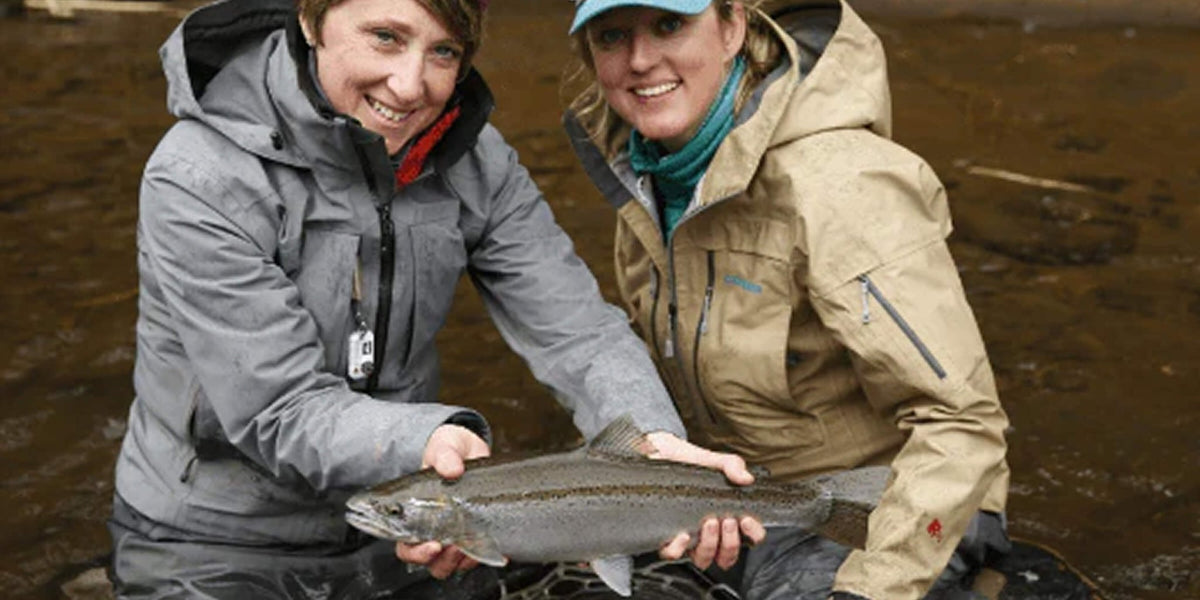
Cold Weather Fishing: Womens Fishing Apparel
|
|
Time to read 6 min

|
|
Time to read 6 min
Cold-weather fishing can feel daunting—but with the right cold weather fishing gear, you’re not just surviving the chill, you’re thriving in it. At Fishe, we hold to one rule: there’s no bad weather, only bad clothing. What follows is a field-tested layering system, plus deep-cut tactics most lists skip—things like MVTR, vapor-barrier tricks, battery behavior in the cold, and rod-guide ice management—so you stay warm, dry, and on the water longer.
Table of contents
If you only remember one concept, make it this: dry equals warm. Your base layer moves sweat off skin; your mid-layer traps heat; your shell blocks wind and spray. Look for shells with high breathability (often listed as MVTR—moisture vapor transmission rate) so sweat can escape instead of condensing inside your system. Numbers vary by test, but MVTR simply tells you how quickly water vapor moves through a fabric; higher is more breathable. SectionHiker+1
"Layers are gears for your body—shift up when you hike in, down when you post up."
A wind-blocking hood + merino beanie + neck gaiter create a warm micro-climate around your most exposed heat exchangers. Wind matters: it accelerates heat loss and can push frostbite risk into short windows depending on temperature and speed. Plan for wind chill, not just the forecast. National Weather Service
Pro move: Think in “CLO” (insulation value). You don’t need to be a lab tech—just know that more CLO = more warmth, and you add or subtract it by swapping mids (light grid fleece vs. big puffy) to hit the day’s target without sweating. Engineering ToolBox
Go modular: thin liner gloves you can tie knots in + over-mitts for boat rides or standing still. Keep a dry backup pair in a zip bag. If you use heated gloves, remember that lithium-ion batteries hate cold and should not be charged below freezing; keep spares warm in an inner pocket and follow manufacturer guidance. Battery University
"Warm hands catch more fish than tough hands"
If you’ve ever shivered mid-river, you already know: water robs heat fast. Build a leg system that respects conduction from cold water—merino or synthetic base bottoms, then add an insulating layer if temps demand it, under breathable waders. Wet feet lose heat ~25× faster than dry; mind moisture and rotate socks if needed. CDC
When it’s brutally cold, slip a vapor-barrier liner (VBL) sock over a thin liner (or use purpose-built VBL socks). It sounds counterintuitive, but by blocking sweat vapor from saturating your insulation, you keep loft—and warmth—intact on long days. Reserve this for truly cold missions and test at home first. Exped
Socks: Midweight merino (no cotton) for moisture management.
Fit: Room to wiggle toes; overly thick socks in tight boots throttle circulation and make feet colder.
Underfoot insulation: Consider modern aerogel-enhanced insoles to reduce heat loss into cold ground or boat decks without adding bulk. REI+1
Reality check: Highly active days need less insulation to avoid sweat; long stationary sessions (indicator nymphing, sled shuttles) demand more. Pick accordingly. REI
Slick rocks and rim ice aren’t a vibe. Pack microspikes in a hip or sling pocket so you can instantly add grip for bank entrances and trail pitches. Reputable models bite ice with ⅜-inch steel teeth and go on/off fast—even with cold fingers. Backpacker+1
Heated vests, socks, and mitts can extend your range, especially for low-exertion fishing. Keep battery packs close to your core (warm = more capacity), bring spares, and avoid charging li-ion cells below 0 °C/32 °F to prevent plating damage. Battery University
Freezing guides shorten casts and snap tippet. Before you launch, coat guides with a purpose-built, non-toxic paste designed for fishing (reapply as needed). On the water, periodically dip your tip in the river to melt buildup; moving water is warmer than subfreezing air. Skip random household sprays—they can be nasty for fisheries. Loon Outdoors+1
"If your guides are icing, your presentation is already losing."
Eat small, frequent snacks (fat + carbs) and sip warm liquids. Use a warm-up cadence: a quick bank hike or a set of air-squats before you step back in the river recharges heat without soaking your base layer.
Wind chill: Check the chart before you go—wind accelerates heat loss and shrinks safe exposure windows for skin. Cover up accordingly. National Weather Service
Hypothermia signs: shivering, fumbling hands, confusion, slurred speech, drowsiness—end the session and rewarm. CDC
Cold water immersion: Know the risk curve—water saps heat dramatically faster than air, so even “mild” water can be dangerous without proper layers and a plan. Princeton University
Above 40 °F (light wind): wicking base + light mid + softshell/rain shell.
25–40 °F (variable wind): wicking base + warm fleece or light puffy + true waterproof shell; add gaiter + beanie.
Below 25 °F or gusty: heavier puffy or vest, upgraded gloves/mitts, warmer socks/insoles, shorten stationary sessions.
Any time you’re wading: dress for the river, not the parking lot—standing in cold water compounds heat loss. Princeton University
"Dry base, breathing shell, happy day."
Base layers: merino or quality synthetics (top & bottom).
Mid-layers: active fleece or puffy(s) you can cast in; think “CLO swaps,” not one magic jacket. Engineering ToolBox
Shell: waterproof/windproof and breathable (mind MVTR so sweat can exit). SectionHiker
Head/neck: beanie + neck gaiter; hooded shell.
Hands: liner + over-mitts; stash a dry backup pair.
Under-wader bottoms: merino/synthetic; add insulation for long stands.
Socks/boots: midweight merino + roomy boots; consider aerogel insoles for bottom-up heat loss. Ortholite
Traction: microspikes for icy approaches/banks. Outdoor Gear Lab
Rod care: non-toxic guide paste; tip-dip to clear ice. Loon Outdoors
Heated gear: warm your batteries; don’t charge below freezing. Battery University
Safety kit: spare dry gloves/socks, chemical hand warmers, small towel, thermos.
I’ll say it again: I hate being cold—but I love chasing fat fall rainbows and feisty spring fish. With dialed cold weather fishing gear, breathable layers that actually breathe, warm hands, and a plan for wind and water, you don’t have to choose. Dress smart, fish safer, and let winter be your season.
What base weight should I choose?
If you’ll hike hard then stand and cast, go lighter base with a beefier mid; if you’re mostly stationary, go heavier base and moderate mid. The goal is to keep the base dry so you don’t flash-chill. REI
Breathable or neoprene waders in winter?
Breathables with proper layering usually win for moisture management and comfort; they let sweat escape and keep you drier during exertion. Add insulation under them for truly frigid water. REI
How do I keep feet warm while standing in a river?
Use midweight merino socks, ensure toe room (circulation!), and add a thermal insole to block bottom-up loss. Over-thick socks in tight boots make feet colder. REI+1
Are lip balms or sprays safe for de-icing guides?
Skip home chemicals. Use a purpose-built, non-toxic paste made for rods/lines and reapply as needed; also dip the tip in water to melt ice. Loon Outdoors+1
Do heated gloves or socks actually help?
Yes—especially for low-movement sessions—but keep batteries warm and never charge below 32 °F to avoid damage. Carry spares close to your body. Battery University
What’s the big deal with wind chill?
Wind accelerates heat loss; at certain temperature/wind combos, exposed skin can freeze quickly. Cover up and reduce exposure on gusty banks and boat runs. National Weather Service
Why is cold water so dangerous compared to cold air?
Water conducts heat away from the body dramatically faster than air; even “cool” water can trigger hypothermia without proper layers. Princeton University